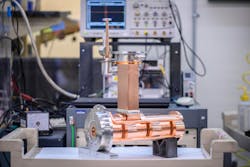DARPA asks industry for rugged mobile electron linear accelerator for bomb disposal and package inspection
ARLINGTON, Va. – U.S. military researchers are asking industry to develop a rugged, compact and deployable electron linear accelerator for remote bomb disposal and detonation, mobile imaging and inspection, sterilization of food and surfaces, and mobile medical applications.
Officials of the U.S. Defense Advanced Research Projects Agency (DARPA) in Arlington, Va., issued a broad agency announcement (HR001121S0006) for the Advanced Concept Compact Electron Linear-accelerator (ACCEL) project.
Applications for such a rugged mobile linear accelerator include:
-- chemical, biological, radiological, nuclear, and explosive (CBRNE) defense;
Related: iRobot lands another Navy contract for ground robots that assist bomb-disposal technicians
-- deployable and mobile active inspection systems for homeland defense and counter-proliferation that use high-energy electrons for package inspection of boxes and metal containers without opening;
-- mobile medical treatment like X-rays, cancer treatments for use in environments that do not have access to state-of-the-art hospitals;
-- portable sterilization capability for foods and surfaces to prevent contamination and infection in deployed environments;
Related: Navy considers bomb-disposal applications that run on tablet computers or smart phones
-- active radiation-belt remediation to improve the lifetime of satellites passing through space radiation belts; and
-- conducting linear accelerator science experiments in locations with difficult terrain, weather, or where it is difficult to transport items heavier than 440 pounds.
In the past, high-power linear accelerators have been too large to be mobile, and linear accelerators that are mobile have had insufficient power to be effective.
CBRNE defense is of particular interest for small mobile electron linear accelerators because they can create x-rays for inspecting suspect areas or containers remotely and detect the presence of nuclear material that might go undetected by other types of inspection. The electron beam also can disable electronic communications or detonation systems at moderate stand-off distances.
The ACCEL program will be in three 10-month phases. The first phase includes a system requirements review (SRR) at month 6 and a system design review (SDR) at the end. The second includes a preliminary design review (PDR) at month 6 and a critical design review (CDR) at month 10. The third phase will deliver the linear accelerator system.
Companies interested should submit abstracts no later than 8 Feb. 2021, and proposals no later than 8 March 2021 to the DARPA BAA Website at https://baa.darpa.mil.
Email questions or concerns to Col. Daniel Javorsek, the ACCEL program manager, at [email protected]. More information is online at https://beta.sam.gov/opp/8edb00d0d261494393d242ec3aa2d415/view.
About the Author
John Keller
Editor-in-Chief
John Keller is the Editor-in-Chief, Military & Aerospace Electronics Magazine--provides extensive coverage and analysis of enabling electronics and optoelectronic technologies in military, space and commercial aviation applications. John has been a member of the Military & Aerospace Electronics staff since 1989 and chief editor since 1995.
